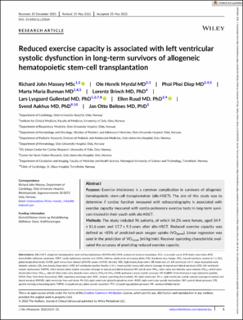| dc.contributor.author | Massey, Richard | |
| dc.contributor.author | Myrdal, Ole Henrik | |
| dc.contributor.author | Diep, Phoi Phoi | |
| dc.contributor.author | Dirdal, Marta Maria | |
| dc.contributor.author | Brinch, Lorentz | |
| dc.contributor.author | Gullestad, Lars | |
| dc.contributor.author | Ruud, Ellen | |
| dc.contributor.author | Aakhus, Svend | |
| dc.contributor.author | Beitnes, Jan Otto | |
| dc.date.accessioned | 2023-02-03T08:23:58Z | |
| dc.date.available | 2023-02-03T08:23:58Z | |
| dc.date.created | 2022-09-27T12:29:50Z | |
| dc.date.issued | 2022 | |
| dc.identifier.citation | Journal of Clinical Ultrasound. 2022, . | en_US |
| dc.identifier.issn | 0091-2751 | |
| dc.identifier.uri | https://hdl.handle.net/11250/3048152 | |
| dc.description.abstract | Purpose
Exercise intolerance is a common complication in survivors of allogeneic hematopoietic stem-cell transplantation (allo-HSCT). The aim of this study was to determine if cardiac function measured with echocardiography is associated with exercise capacity measured with cardio-pulmonary exercise tests in long-term survivors treated in their youth with allo-HSCT.
Methods
The study included 96 patients, of which 54.2% were female, aged 34.9 ± 11.6 years and 17.7 ± 9.3 years after allo-HSCT. Reduced exercise capacity was defined as <85% of predicted-peak oxygen uptake (VO2peak). Linear regression was used in the prediction of VO2peak (ml/kg/min). Receiver operating characteristic evaluated the accuracy of predicting reduced exercise capacity.
Results
VO2peak was 36.2 ± 7.7 ml/kg/min and 43 (44.8%) had reduced exercise capacity. Left ventricular ejection fraction was 55.4 ± 5.9% and global longitudinal strain (GLS) was −17.6% ± 2.0%. Left and right ventricular functions were significantly lower in survivors with reduced exercise capacity. Increased body mass index, lower physical activity score, reduced pulmonary function (by forced expiratory volume in 1-s) and reduced left ventricular systolic function (by GLS) were significant independent predictors for reduced VO2peak. GLS was superior to other echocardiographical indices for identifying reduced exercise capacity (area under curve = 0.64, p = 0.014).
Conclusions
Left ventricular systolic dysfunction measured by GLS is associated with reduced exercise capacity in long-term allo-HSCT survivors. | en_US |
| dc.language.iso | eng | en_US |
| dc.publisher | Wiley | en_US |
| dc.rights | Navngivelse 4.0 Internasjonal | * |
| dc.rights.uri | http://creativecommons.org/licenses/by/4.0/deed.no | * |
| dc.title | Reduced exercise capacity is associated with left ventricular systolic dysfunction in long-term survivors of allogeneic hematopoietic stem-cell transplantation | en_US |
| dc.title.alternative | Reduced exercise capacity is associated with left ventricular systolic dysfunction in long-term survivors of allogeneic hematopoietic stem-cell transplantation | en_US |
| dc.type | Peer reviewed | en_US |
| dc.type | Journal article | en_US |
| dc.description.version | publishedVersion | en_US |
| dc.source.pagenumber | 0 | en_US |
| dc.source.journal | Journal of Clinical Ultrasound | en_US |
| dc.identifier.doi | 10.1002/jcu.23264 | |
| dc.identifier.cristin | 2055861 | |
| cristin.ispublished | true | |
| cristin.fulltext | original | |
| cristin.qualitycode | 1 | |

